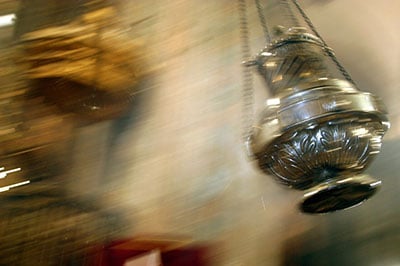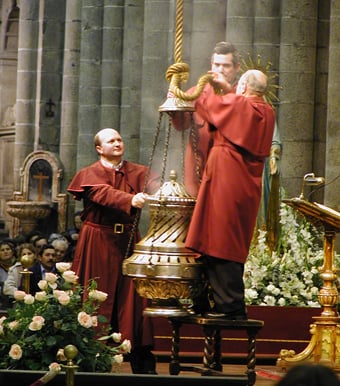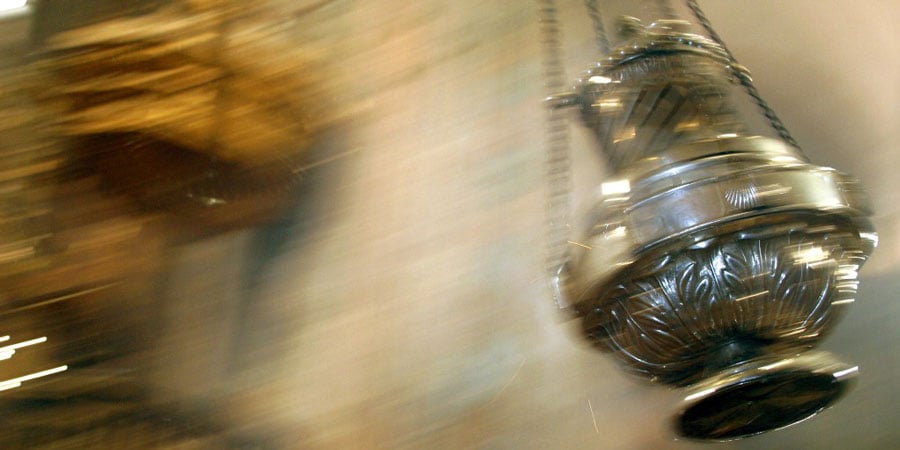What Is the Botafumeiro?
The Botafumeiro is the famous giant thurible used in the Santiago de Compostela Cathedral. It has swung since the Middle Ages to cleanse the air when pilgrims arrived after their long Camino de Santiago journey.
Table of contents
- What Is the Botafumeiro?
- Historical Reference
- The Current Botafumeiro
- How the Botafumeiro Works
- Swinging Speed and Usage
- Botafumeiro Calendar of Use
- Contact Information for Bookings
- Description of the Botafumeiro
- The Alcachofa Thurible
- Ropes and Operation Details
- Swinging Details
- The Meaning Behind the Botafumeiro
- Who Are the Tiraboleiros?
- History of the Botafumeiro
- Notable Accidents with the Botafumeiro
Historical Reference
The Codex Calixtinus, the first Camino guidebook, calls the Botafumeiro Turibulum Magnum. This shows the ritual dates back to at least the 12th century.
The Current Botafumeiro
The present Botafumeiro was made in 1851 from silver-plated brass. It weighs 53 kilograms empty and up to 63 kilograms when full. Eight men called Tiraboleiros operate it.
How the Botafumeiro Works
After the Tiraboleiros fill it with incense and coal, the 1.5-metre-high Botafumeiro is attached to a rope by the altar. It swings in a 65-metre arc across the cathedral.
Swinging Speed and Usage
In just 90 seconds, the Botafumeiro can reach speeds of 68 km/h. It is used on special liturgical dates like Christmas and Saint James Day.
Botafumeiro Calendar of Use
- 6th January: Epiphany
- Easter Sunday
- Ascension of Our Lord (May)
- 23rd May: Apparition of the Apostle
- Pentecost Sunday
- 25th July: Feast of Saint James
- 15th August: Assumption of the Blessed Virgin
- 1st November: All Saints’ Day
- Feast of Christ the King (November)
- 8th December: Immaculate Conception
- 25th December: Christmas Day
- 30th December: Arrival of the Holy Apostle
Check the cathedral’s official website for calendar updates and to book a Botafumeiro performance.
Contact Information for Bookings
Requests can be made at the Pilgrims Office:
Address: Rúa Carretas, 33, CP 15705, Santiago de Compostela
Phone: +34 981 568 846
Email: botafumeiro at catedraldesantiago.es
Or just go to the Website and contact them: peregrinossantiago.es
Description of the Botafumeiro
The Botafumeiro hangs from a pulley system installed in 1604 in the cathedral’s dome. The current vessel is brass and bronze alloy plated with thin silver. The goldsmith José Losada created the present Botafumeiro in 1851. It weighs 80 kg and stands 1.6 metres tall, making it the largest swinging thurible in the world. Usually, it is displayed in the cathedral’s library but is brought down for important religious celebrations.

The Alcachofa Thurible
Another large censer used in the cathedral is known as “La Alcachofa” or “The Artichoke.” Craftsman Luis Molina Acedo created it in 1971.
Ropes and Operation Details
The ropes last around 20 years but sometimes need earlier replacement due to wear. They initially used hemp or esparto grass ropes, but since 2004, they have switched to synthetic ones.
The Tiraboleiros fill the Botafumeiro or Alcachofa with about 40 kg of charcoal and incense. They then tie it to the rope with special knots and begin swinging it.
Swinging Details
The censer swings almost to the transept ceiling, reaching speeds of 68 km/h and heights of 21 metres. It arcs 65 metres between the Azabachería and Praterias doors.
The swinging lasts about 80 seconds, completing roughly 17 cycles. Each performance costs about €250 and draws many pilgrims and visitors.
The Meaning Behind the Botafumeiro
The Botafumeiro releases thick incense clouds, echoing the saying, “More incense, less nonsense.” It is a visual and spiritual highlight of the pilgrimage experience.
Who Are the Tiraboleiros?
Eight men in red robes called Tiraboleiros carry and swing the Botafumeiro. The term comes from Latin, meaning “incense carrier”. The current chief is Armando Raposo.
History of the Botafumeiro
The swinging censer tradition likely began in the 11th century to freshen the air of weary, unwashed pilgrims. Incense also symbolised prayer and protection during plagues. In the 13th century, engineers improved the pulley mechanism by adding coaxial drums, enabling wider swings than the rope alone allowed.
King Louis XI of France funded a new silver thurible in the 15th century. However, Napoleon’s troops stole it in 1809 during the Spanish War of Independence. The present Losada thurible replaced the stolen one in 1851. Skilled artisans restored it in 2006, repairing the damage and reapplying the silver plating.

Notable Accidents with the Botafumeiro
Several accidents happened during swinging. Once, the Botafumeiro detached and flew out a window in 1499 during Princess Catherine of Aragon’s visit. No one reported any injuries.
In 1622, 1925, and 1937, the ropes failed, causing the Botafumeiro to fall or spill hot coals. Today, they secure it with sailor’s knots to prevent accidents.
Contact our travel experts for help planning or booking your Camino de Santiago journey. Use our Camino Planner to receive an instant quote tailored to your trip.




Gentlemen; my wife and I are planning to be in Santiago de Compostela on november 1st, with the intention to be present at the butafumeiro tradition. We want to know if we have to buy tickets in advance for the particular experience, and if so, where to buy them
Hi Jose, there is no need to buy tickets but you can find more information here: https://caminoways.com/botafumeiro-santiago-de-compostela and here: https://caminoways.com/cathedral-of-santiago-de-compostela
Hope you enjoy your experience in Santiago!
we are coming for Christ the King services and would like to know when the botafumiero traditional swinging will occur on that date.
Hi Len, thanks for your message. For more information, please visit: https://caminoways.com/botafumeiro-santiago-de-compostela
Hello, My husband and I will be in Santiago and celebrating our 25th anniversary after completing the camino. Our anniversary is in September. Will there be any botofumeiros performances in September?
Hi Jill, thanks for your message and congratulations on your 25th anniversary, what a wonderful way to celebrate. The Botafumeiro operates on the holidays stated above but you are able to request it by emailing the church so that could be an idea if you wanted to do that! Hope that helps and congratulations again!
Hello, is the Botofumeiros performed at the pilgrim mass each Friday night ?
Hi Joel, the calendar of events mentioned are the definite times the Botafumeiro. For any changes or news, please check the official cathedral website as they will have the most up-to-date information.